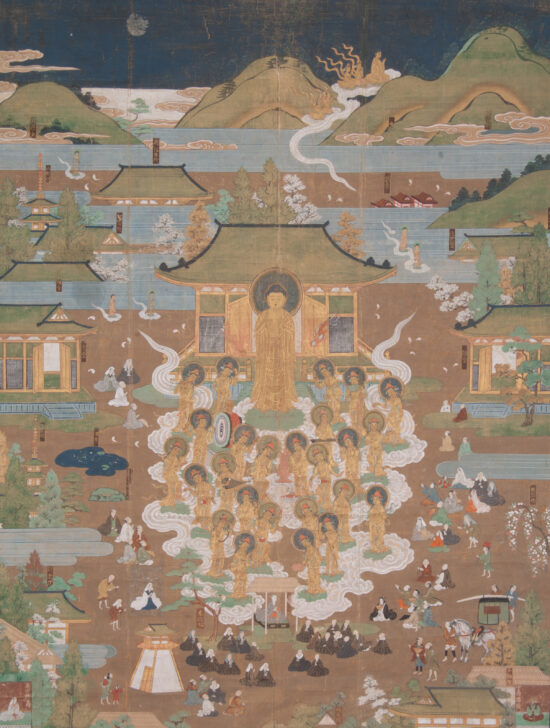Taima Temple Mandala: Amida Welcomes Chûjôhime to the Western Paradise
Japanese

Description
Gallery Rotation Fall 2013
Taima Temple Mandala: Amida Welcomes Chûjôhime to the Western Paradise
Japan, Muromachi period (1333–1573)
16th century
Hanging scroll, ink, color and gold on silk
Museum purchase made possible by the Margaret Watson Parker Art Collection Fund, 2002/1.169
A mandala is a magical diagram of the cosmos made for ritual purposes. In Japan, the mandala was adapted to include topographical views of actual Buddhist temples and Shinto shrines as a way of incorporating them into a sacred landscape. Temple and shrine mandalas painted on large cloths were also used as teaching and fundraising tools by itinerant monks and nuns, especially in the fourteenth through sixteenth centuries.
The layout of the buildings and the surrounding hills identifies this picture as a view of the compound and environs of Taima Temple, which lies at the foot of Nijô Mountain, southeast of modern Osaka. What distinguishes this work from others of its type is the addition of a narrative uniting the temple’s principal deity and most famous resident: the Buddha Amida welcomes the young nun Chûjôhime to paradise. This event is witnessed by a gathering of nuns and laymen in contemporary costume—and, by implication, all viewers of the painting.
Subject Matter:
A mandala depicting a view of the area around Taima Temple which is at the foot of Nijo Mountains, southeast of Osaka. This piece is unique because it also includes a narrative uniting the temple's principal deity, the Buddha Amida, and one of the famous residents of the temple, Chujohime. The Buddha is welcoming Chujohime to paradise, surrounded by nuns and laymen serving as witnesses.
Physical Description:
At the center of the mandala is Amidha Buddha, surrounded by other golden holy figures on clouds, indicated by the rings around their heads. On the ground surrounding the figures are seated men and women in variously colored robes. At the center and front of the holy beings is a man dressed in a grey robe seated under an awning. One of the holy figures is offering him a lotus blossom.
Behind the Buddha is a temple. To the left and right of this are partial views of smaller buildings. The background of the image also contains buildings and mountains, partially obscured by mist. Among the back mountains is a trail of clouds with other holy figures heading into the sky.
Usage Rights:
If you are interested in using an image for a publication, please visit https://umma.umich.edu/request-image/ for more information and to fill out the online Image Rights and Reproductions Request Form.